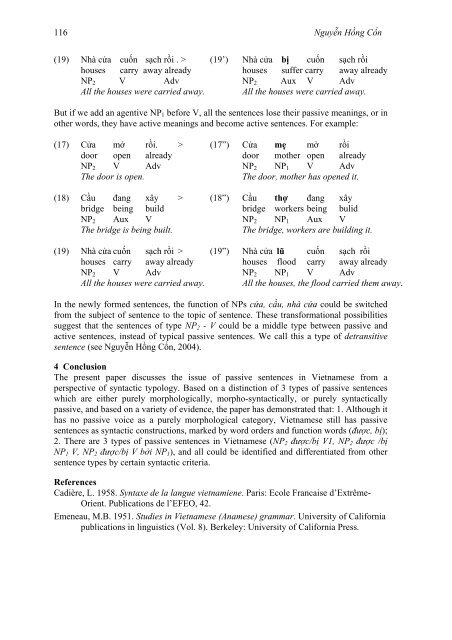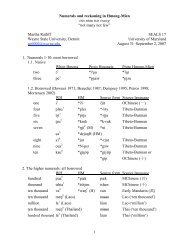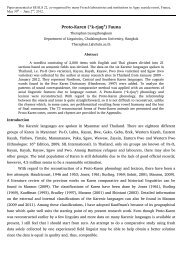proto-southwestern-tai revised: a new reconstruction - seals 22
proto-southwestern-tai revised: a new reconstruction - seals 22
proto-southwestern-tai revised: a new reconstruction - seals 22
You also want an ePaper? Increase the reach of your titles
YUMPU automatically turns print PDFs into web optimized ePapers that Google loves.
116 Nguyễn Hồng Cổn<br />
(19) Nhà cửa cuốn sạch rồi . > (19’) Nhà cửa bị cuốn sạch rồi<br />
houses carry away already houses suffer carry away already<br />
NP2 V Adv NP2 Aux V Adv<br />
All the houses were carried away. All the houses were carried away.<br />
But if we add an agentive NP1 before V, all the sentences lose their passive meanings, or in<br />
other words, they have active meanings and become active sentences. For example:<br />
(17) Cửa mở rồi. > (17”) Cửa mẹ mở rồi<br />
door open already door mother open already<br />
NP2 V Adv NP2 NP1 V Adv<br />
The door is open. The door, mother has opened it.<br />
(18) Cầu đang xây > (18”) Cầu thợ đang xây<br />
bridge being build bridge workers being bulid<br />
NP2 Aux V NP2 NP1 Aux V<br />
The bridge is being built. The bridge, workers are building it.<br />
(19) Nhà cửa cuốn sạch rồi > (19”) Nhà cửa lũ cuốn sạch rồi<br />
houses carry away already houses flood carry away already<br />
NP2 V Adv NP2 NP1 V Adv<br />
All the houses were carried away. All the houses, the flood carried them away.<br />
In the <strong>new</strong>ly formed sentences, the function of NPs cửa, cầu, nhà cửa could be switched<br />
from the subject of sentence to the topic of sentence. These transformational possibilities<br />
suggest that the sentences of type NP2 - V could be a middle type between passive and<br />
active sentences, instead of typical passive sentences. We call this a type of detransitive<br />
sentence (see Nguyễn Hồng Cổn, 2004).<br />
4 Conclusion<br />
The present paper discusses the issue of passive sentences in Vietnamese from a<br />
perspective of syntactic typology. Based on a distinction of 3 types of passive sentences<br />
which are either purely morphologically, morpho-syntactically, or purely syntactically<br />
passive, and based on a variety of evidence, the paper has demonstrated that: 1. Although it<br />
has no passive voice as a purely morphological category, Vietnamese still has passive<br />
sentences as syntactic constructions, marked by word orders and function words (được, bị);<br />
2. There are 3 types of passive sentences in Vietnamese (NP2 được/bị V1, NP2 được /bị<br />
NP1 V, NP2 được/bị V bởi NP1), and all could be identified and differentiated from other<br />
sentence types by cer<strong>tai</strong>n syntactic criteria.<br />
References<br />
Cadière, L. 1958. Syntaxe de la langue vietnamiene. Paris: Ecole Francaise d’Extrême-<br />
Orient. Publications de l’EFEO, 42.<br />
Emeneau, M.B. 1951. Studies in Vietnamese (Anamese) grammar. University of California<br />
publications in linguistics (Vol. 8). Berkeley: University of California Press.





